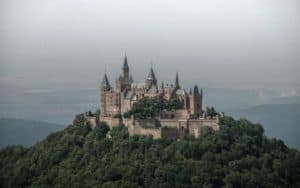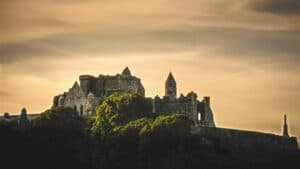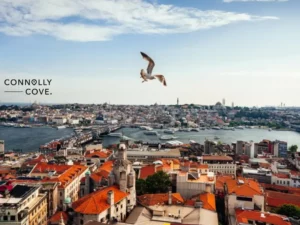Unravelling the Enigma of Valkyrie Mythology: Divine Maidens and Choosers of the Slain

Updated On: April 28, 2024 by Fatma Mohamed
Valkyrie Mythology: Enigmatic, elusive, and deeply ingrained in the tapestry of Norse folklore, the legends of the Valkyries stand as a testament to the fascination humans hold for the divine and the mysterious. These ethereal beings, often depicted as warrior maidens soaring through the skies, hold a unique place in the pantheon of Norse mythology as both guardians of the slain and harbingers of destiny. But beyond their iconic imagery lies a web of stories, beliefs, and interpretations that have captivated scholars and enthusiasts alike for centuries.
At the heart of Valkyrie mythology lies the dual role of these celestial beings as both fierce warriors and compassionate guides. Known as “choosers of the slain,” Valkyries are said to descend upon the battlefield, selecting brave warriors deemed worthy of entry into Valhalla, the legendary hall of Odin. Yet, beneath their armour and steely gaze, there exists a complexity that transcends mere battlefield prowess. Valkyries are not just arbiters of death but also bearers of fate, weaving the threads of destiny with each soul they escort to the afterlife.

But who are these enigmatic figures, and what deeper truths lie concealed within their myths? To unravel the intricacies of Valkyrie mythology is to embark on a journey through the realms of both mortal and divine, where tales of heroism, sacrifice, and divine intervention intertwine to shape the very fabric of Norse belief. Join us as we delve into the rich tapestry of Valkyrie lore, seeking to decipher the secrets of these divine maidens and uncover the profound significance they hold within the mythological landscape.
Table of Contents
Who are the Valkyries?
These legendary figures are more than just beautiful maidens. Valkyries were powerful women who played a crucial role in Norse mythology, weaving tales of war, death, and the afterlife.
Definition and Meaning
The word “valkyrie” comes from Old Norse valkyrja, which translates literally to “chooser of the slain.” This aptly describes their primary function: selecting warriors who fell valiantly in battle.
They are strong women who help Odin, the top Norse god. Their name means ‘chooser of the slain’. They ride horses and fly over battles. When a warrior dies, they pick him to go to Valhalla with Odin.
In this special place, the warriors live again after death. Some people see Valkyries as angels in other tales. We don’t know how many there were, but they all had a big job in Norse myths—choosing who goes to Asgard via Bifrost bridge.
Role in Norse Mythology

Imagine a battlefield filled with clashing steel and thunderous roars. The Valkyries, clad in shimmering armour and riding magnificent steeds, soared through the carnage. These formidable women weren’t just observers; they actively decided the fate of warriors. Those deemed worthy by the Valkyries were granted a glorious afterlife in Valhalla, the majestic hall of the god Odin.
In Norse mythology, the Valkyries played an important role as divine maidens and choosers of the slain. They were considered handmaidens of Odin, the All-Father and chief god of the Norse pantheon.
Sent by Odin to the battlefields, these powerful warrior women rode on horses through the skies, selecting brave warriors who had fallen in combat. The Valkyries would then bring these chosen heroes to Valhalla, a majestic hall where deceased warriors would feast and prepare for Ragnarok, the ultimate battle between gods and giants.
With their ability to determine who would enter Asgard, home of the gods, the Valkyries held great power and significance in Norse culture.
Connection to Odin and Valhalla

Odin, the Allfather in Norse mythology, held dominion over war and death. The Valkyries served as his chosen agents, selecting the bravest and most skilled warriors to join the ranks of the Einherjar, Odin’s elite army who would fight alongside him at Ragnarok, the prophesied end of the world. Within Valhalla, the Valkyries weren’t just fierce warriors; they also served mead to the Einherjar as they prepared for the final battle.
The Valkyries played a crucial role in ensuring that worthy warriors would be granted a place in Odin’s sacred realm. Their association with Odin showcases their importance and significance in Norse culture, as they were instrumental in carrying out his divine will.
Powers and Abilities
Valkyries possessed an awe-inspiring range of abilities. They could ride through the air on horseback or transform into birds, often ravens, soaring above the battlefield. They were skilled in warfare, wielding magical weapons and influencing the course of battles. Some accounts even suggest they could influence the outcome of a warrior’s life, not just their death.
With their trusty spears, they bravely faced any enemy that stood in their way. These warrior women were also associated with animals like wolves and boars, which added to their fierce nature.
Additionally, the Valkyries had a connection to immortality, serving as handmaidens to Odin himself. As divine beings of Norse mythology, they held great power and influence over the fate of fallen warriors on the battlefield.
Exploring the Enigma of Valkyrie Mythology

The Valkyries, with their blend of beauty and brutality, have captivated imaginations for centuries. But where did these mythical beings come from, and what deeper meaning do they hold? Let’s delve into the enigmatic world of Valkyrie mythology.
Origins and Development
The origins of the Valkyries are shrouded in mystery. While some scholars believe they may have stemmed from a pan-Germanic tradition of death spirits, others see them as a uniquely Norse creation. Early mentions of Valkyrie-like figures appear in Poetic Edda, a collection of Viking Age poems, suggesting these concepts were well-established by the 9th or 10th centuries.
Over time, their role and significance evolved, becoming intertwined with the concept of Valhalla—the great hall where fallen warriors would feast and prepare for Ragnarok, the final battle.
As part of their duties, Odin sent Valkyries to battlefields to choose which warriors would join him in Valhalla after death. They were often depicted as beautiful maidens riding on horseback through the skies above battles.
Valkyrie mythology has captured the imagination of people throughout history and continues to hold cultural significance today. In popular culture, they are often portrayed as strong and fierce warrior women who embody bravery and heroism.
Theories and interpretations

The multifaceted nature of the Valkyries has led to a variety of interpretations. Some see them as purely physical beings, Odin’s chosen warriors. Others propose a more spiritual role, with Valkyries representing aspects of fate or the afterlife. Freudian interpretations delve into the concept of a powerful, independent female archetype existing within a male-dominated pantheon.
There are various theories and interpretations surrounding Valkyrie mythology. One theory suggests that Valkyries were originally warrior women who fought alongside men in battle. Another interpretation is that they represent the personification of death, guiding the souls of fallen warriors to the afterlife.
Some believe that Valkyries symbolise female empowerment and independence, as they are fierce and fearless beings. Additionally, there is speculation about the significance of their association with Odin and Valhalla, with some suggesting a deeper spiritual connection between them.
Overall, these theories and interpretations contribute to the enigma surrounding Valkyrie mythology, adding depth and intrigue to their role in Norse culture.
Significance and Symbolism in Norse Culture

The Valkyries embodied the harsh realities of Viking life. War and death were ever-present, and the Valkyries served as a reminder of both their brutality and the potential for an honourable afterlife. Their fierce independence and connection to Odin also likely resonated with Norse society, where strength and courage were highly valued.
This symbolises their role in determining who would have a place in the halls of the gods after death. The Valkyries were also associated with animals like horses, wolves, and boars, which further enhanced their connection to battlefields and war.
Their presence in Norse culture showcases the importance of valour and honour on the battlefield and reinforces the belief in an afterlife where warriors could find eternal glory alongside Odin.
Famous Valkyries in Mythology
Norse mythology features several prominent Valkyries, each with their own unique qualities. Brynhildr, known for her defiance and tragic love story, is perhaps the most well-known. Others, like Hildr (“battle”) and Sigrún (“victory”), have names that directly reflect their warlike nature. Exploring the individual stories of these Valkyries offers a deeper understanding of their place in Norse mythology.
These valiant and powerful women embody bravery, honour, and strength as they choose warriors for the afterlife in Valhalla. Their stories continue to captivate us with their courage and mythical prowess.
Conclusion
The Valkyries, with their blend of battlefield prowess and otherworldly grace, continue to enthral us today. Their story transcends the realm of mere myth, offering a window into the hearts and minds of the Viking people. As we delve deeper into their enigmatic existence, we gain a richer understanding of their role in Norse mythology, their connection to the divine, and the values they embodied. The Valkyries serve as a powerful reminder that even in the face of war and death, there is a place for courage, honour, and the unwavering hand of fate.
FAQs
1. Who are the Valkyrie warriors in Nordic folklore?
Valkyrie warriors are warrior women and demigoddesses from Nordic folklore who choose those slain in battle.
2. What is the role of Valkyrie in Norse mythology?
In Norse mythology, Valkyries served AllFather Odin, choosing who would live or die during a war and hosting them in the afterlife.
3. Do Valkyries have any relation to wolves in Scandinavian legends?
Yes! In some instances, these mythical creatures were depicted with wolves – showing their fierce, untamed nature.
4. How does the Battle of Ragnarok relate to the valkyries?
Valkyrie symbolism plays a key role in the Battle of Ragnarok, where they select honourable fighters who have fallen onto the battlefield for an afterlife under Odin’s rule.
5. Are there other stories featuring these divine maidens besides battles and death?
Apart from war tales, there exist many fascinating stories within ‘Unraveling the Enigma of Valkyrie Mythology: Divine Maidens and Choosers of Slain’ that showcase their association with various Nordic gods and goddesses.






